Aogashima (青ヶ島) – A Tiny Volcanic Island 350km South of Tokyo
May 27, 2018
The silhouette of Aogashima
I have always felt most at home in places where the land meets the ocean.
I am irresistibly drawn to tiny islands.
There’s something about the colliding of two worlds; a tiny sanctuary poking up from depths of unfathomable blue.
The power and scale of this force is humbling and a little bit terrifying. Nothing makes me feel more alive.
Lately I have taken to selecting travel destinations by searching maps for remote specks of land. The smaller the speck, and the more immense the surrounding blue, the more magnetic its pull.
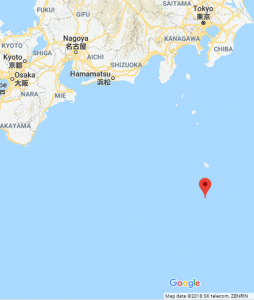
Aogashima’s position in relation to Tokyo
So, imagine my excitement when I found this ‘speck’ more than 350 km south of Tokyo.
A quick search of the name ‘Aogashima’ (青ヶ島) revealed stunning aerial shots of the volcanic island and I was hooked.
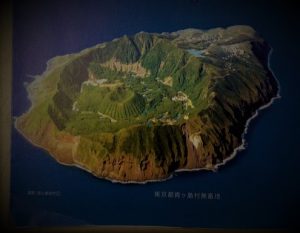
An aerial view of Aogashima
So, how to get there?
Aogashima can be accessed by ferry or helicopter from neighbouring Hachijo-jima (八丈島).
Don’t have your onward travel plans set in stone as the ferry is often cancelled due to rough seas. You could find yourself stranded for a few days.
I was there in June and didn’t experience any cancellations. However, the relatively calm waters were enough to induce sea sickness, so do bring tablets if you don’t have good sea legs.
Nausea aside, the two and a half hour ferry ride is one of the most enjoyable parts of the trip for an ocean lover. You can buy tickets from the office at Sokodo Port and it costs ¥2500 each way. The boat doesn’t run every day so you will need to be flexible.
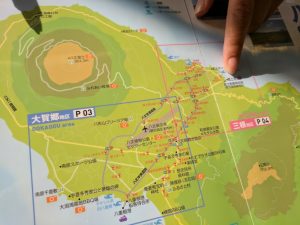
The ferry leaves from Sokodo Port on Aogashima
The more extravagant helicopter option was over my budget at around ¥12 000 each way but it would undeniably provide stunning aerial views of Aogashima’s unique geology with its outer caldera and inner cone.
Spending the night on Hachijo-jima
We spent the night on Hachijo-jima in a dormitory at Seadive Guest House for ¥2500 per person per night. This was ideal as it is located overlooking Sokodo Port. You can see the ferry from your window.

The ferry to Aogashima
The price included airport pickup and was arranged at the tourist information desk in the airport without a prior booking. The less spontaneous among you might prefer to reserve a place in advance.
The location is also perfect in the event of ferry cancellations. You should be able to easily extend your stay and won’t have hauled your luggage halfway across the island to discover that the boat isn’t showing up.
Like almost every hostel I have stayed at in Japan, Seadive was immaculate and everything looked brand new. There are basic cooking facilities, showers and a washing machine. You get your own ‘booth’ with a curtain so it feels private. I LOVE staying in Japanese hostels.
As the name suggests, they also run diving tours with a focus on sea turtles. I wasn’t there long enough to try one out but did get to enjoy footage of the turtles in the lobby and would go back in a heartbeat.
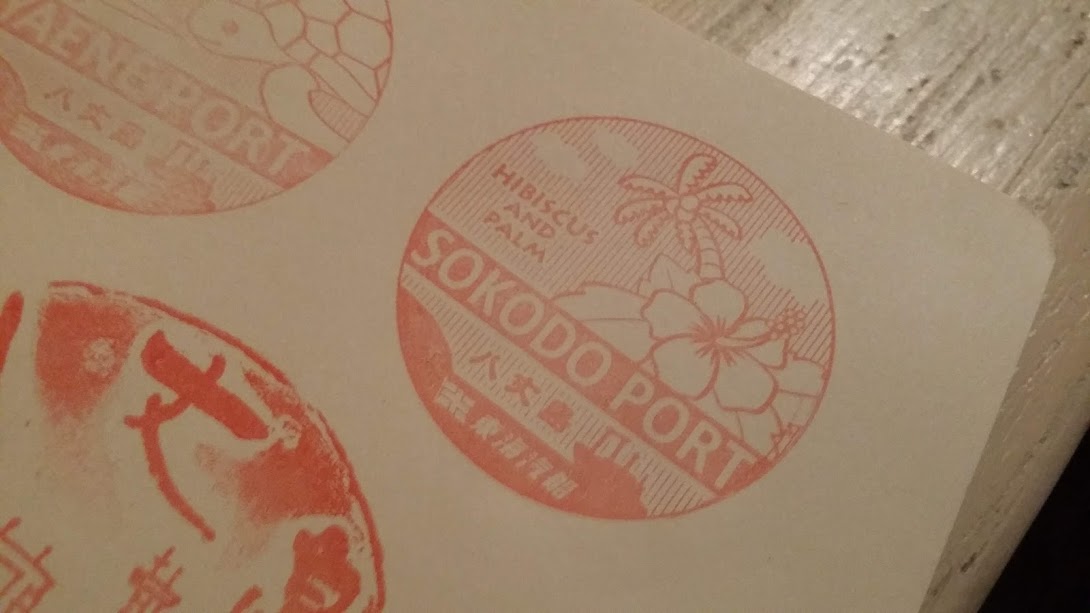
Stamps can be collected in ports and on ferries, as well as many other places in Japan
Where to stay?
Aogashima is only a few kilometres square and currently home to a population of around 170 people.
A few of the inhabitants run guest houses for tourists. There is not much infrastructure on the island (no restaurants and only one shop) but if you stay at a guest house, meals will be included in the price of your stay.
We did manage to find a post office to withdraw money, but it’s best to bring enough to cover your accommodation as you will need to pay in cash.
You won’t be allowed to board the ferry without having booked a place to stay on the island. If you haven’t made prior arrangements, this can be booked through the tourist information desk next to the ticket office.
Our guest house cost ¥9000 per person per night including three meals each day. Our host picked us up and dropped us off at the harbour and graciously accommodated our request for vegetarian food. Dinner also came with shochu, a local alcohol made from sweet potatoes. It is stronger and harsher tasting than sake.
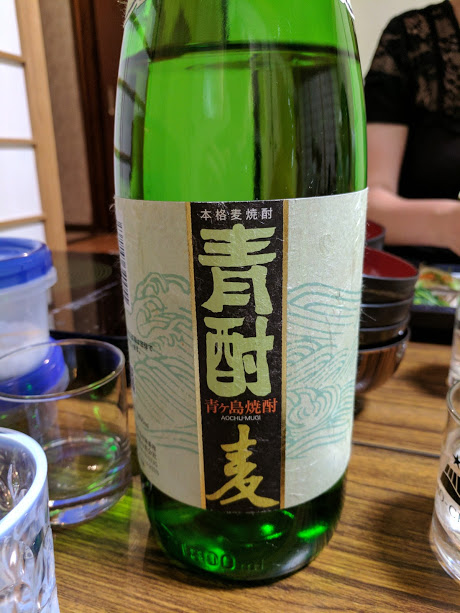
A bottle of locally brewed shochu
There is a list of available accommodation on the island’s tourism website (in Japanese only).
If you are more prepared than I was and have your own tent then you can camp on the island for free for up to a week. You will need to make a booking two weeks in advance by email.
Contact: kankou@vill.aogashima.tokyo.jp
You will also need to register at the town hall on arrival. Make sure to take water and food supplies. There is one shop on the island and the campsite is in the crater of a volcano, so stock up before pitching your tent.
So what is there to do on a tiny island in the middle of nowhere?
How about cooking your dinner on a volcano?
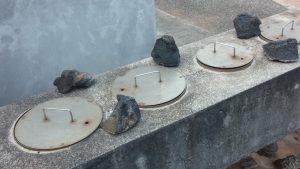
A row of cooking pots
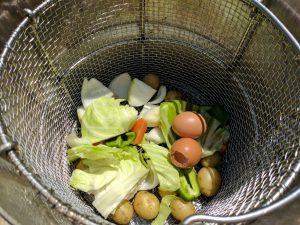
Your food goes into a wire pot and cooks with steam from the volcano
Aogashima is an active volcano. Cooking pots fueled by geothermal energy can be found next to the campsite. Anyone can make use of these for free. We set off from our guest house armed with a packed lunch of eggs and veggies and this charming but slightly confusing map:
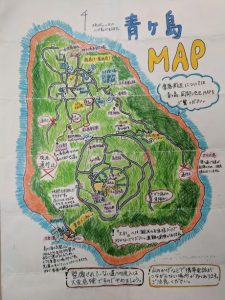
The map we were given of the island
We got just the right amount of lost and hungry before arriving at this remarkable spot in the centre of the island:
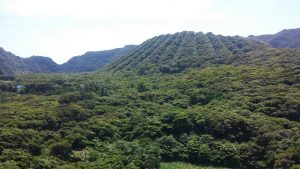
The inner caldera
For ¥300 you can further enjoy the power of the volcano at the onsen (hot spring) which is located right next to the camping ground. The onsen also has a vending machine which dispenses cold drinks (including beer, in case you were wondering).
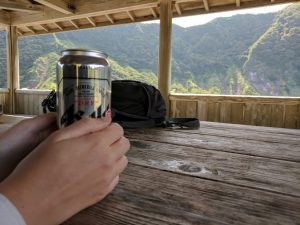
Nursing a cold can of Asahi
Once you are suitably refreshed, you can walk around the rim of the inner cone, which supplies views down into the smaller, central crater.
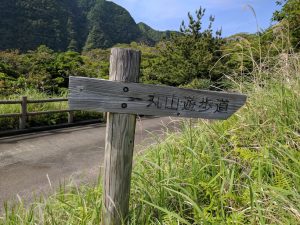
A sign pointing to the ridge of the caldera

The view inside the crater
What about transport?
There are no buses on the island. Due to its size, everything is accessible by foot. You will be inside a volcanic crater so most of the roads and pathways will be steep. Wear comfortable shoes, take breaks and expect to be happily exhausted by the end of your trip.
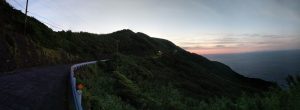
The sun setting during the long walk back to the guest house
If you’re not able to walk far, consider staying a few extra days so you can see the island at your own pace. We stayed two nights which felt just about right.
The main hiking destination on the island is Otonbu (大凸部). This is the highest point on Aogashima and provides views over the whole island.
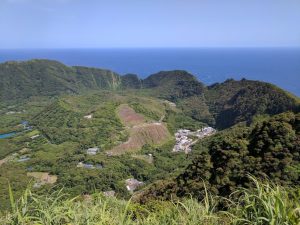
The view from Otonbu
If you are staying in a guest house then Otonbu only requires about twenty minutes of ascent. Hiking down into (and back out of) the crater (where the onsen and campsite are located) is a bigger challenge and will require several hours. It’s totally worth it though as you get to see and feel the volcano up close and personal.
Take your time meandering around the island and you will find many hidden gems along overgrown paths.
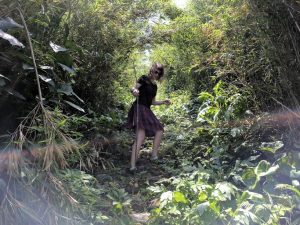
Exploring one of the overgrown paths
Star Gazing
Aogashima’s remoteness ensures that there is almost no light pollution and its spectacular night sky is a huge draw for visitors. This is of course weather dependent. So if it is the primary reason for your visit, you might want to consult weather forecasts and stay a little longer to wait for optimal conditions.
This is the kind of image promised by the guidebook:

Stunning views of the Milky Way are possible under the right weather conditions
My photographs of the night sky were a little less impressive:

My view of the Milky Way 😉
No, really. There are stars there. Go fetch your reading glasses, or a magnifying glass. (It helps if you squint a bit, and have a good imagination.)
I’m sure the kind of images captured in the brochure require more technical equipment than a phone camera. I am also assured that the sky can be spectacular when viewed with the naked eye. I guess this requires a combination of luck and persistence, which eluded us on this trip.
Regardless, there is ample beauty on this island even with full cloud coverage. It’s a reminder that nature calls the shots. And it gives me an excuse to return to Aogashima someday.
Two happy adventurers were dropped off back at the harbour with our lovingly prepared veggie bentos, ready for our next island adventure.

A veggie bento for the road
Leave a Reply